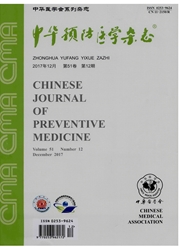

 中文摘要:
中文摘要:
目的了解当前市售食品碘含量,部分大学生膳食碘营养状况,碘盐对膳食摄入碘的补充作用,以及尿碘测定结果对膳食碘的反映程度。方法分层随机采集日常市售食物278份,采用砷铈接触法测定食品碘含量,膳食记录法调查学生的7日膳食情况,砷铈催化分光光度法测定尿碘。结果47种、278份食物样品的检测表明,动物性食品的含碘量(7.8ug/100g~30.8ug/100g)高于植物性食品的含碘量(1.8ug/100g~16.1ug/100g)。膳食调查显示该类学生中以素食为主的占70.19%,以食物碘含量的实测值和膳食调查结果计算出由食物中摄入碘的量为(111.67±53.18)ug/d,而从碘盐中补充碘量(230.27±45.55)ug/d,那么从膳食中共可以摄入碘(341.95±89.58)ug/d。经尿肌酐校正后每克肌酐尿中碘含量中位数为271.28ug/gCr。经尿肌酐校正后的尿含碘量与膳食摄碘量呈正相关关系(0=0.463,P〈0.01)。结论这部分学生多数来自低收入家庭且膳食以素食食物为主,每日从膳食中摄入的碘量低于碘的推荐供给量(RDA)150ug,但是从加碘食盐中可以获得碘230.27ug,从而弥补膳食摄碘量的不足。
 英文摘要:
英文摘要:
Objective To know about content of iodine in foods sold in Tianjing markets presently, and the iodine nutrition conditions in college students. It was also aimed to probe the functions of the iodized salt complement with the dietary iodine intake, and whether the urine iodine could reflect dietary iodine intake. Methods 278 food samples in markets were collected by a randomly stratified sampling method, while the arsenic-cerium catalytic contact method was used to determine the content in food. The dietary information of students for seven days was recorded, and the urine iodine was determined through the arsenic-cerium catalytic spectrophotometry. Results The determination of 47 kinds and 278 food samples indicated that the content of iodine within animal foods (7. 8 ug/100 g -30. 8 ug/100 g) was higher than that within plant foods( 1.8 ug/100 g - 16. 1 ug/100 g). The investigation also showed that students who regarded vegetarian food as principle accounted for 70. 19%. The amount of dietary iodine intake among those students, based on the dietary survey, was( 111.67 +-53. 18 )ug/d, while supplementary iodine from iodized salt was about ( 230. 27 +- 45. 55) ug/d. Therefore, the total iodine provided from diet would be ( 341.95 +-89.58) ug/d. Modified by urine creatinine, the median of urine iodine was 271.28 ug/gCr, and the urine iodine and dietary iodine intake was found positively related (L = 0. 463, P 〈 0. 01 ). Conclusions Regarding the vegetarian food as the principle, most of students investigated are not rich. The dietary iodine intake is lower than RDA ( 150 ug), but it can be obtained the iodinzed salt by 230. 27 ug, which is the possible supplement to the shortage from foods.
 同期刊论文项目
同期刊论文项目
 同项目期刊论文
同项目期刊论文
 期刊信息
期刊信息
